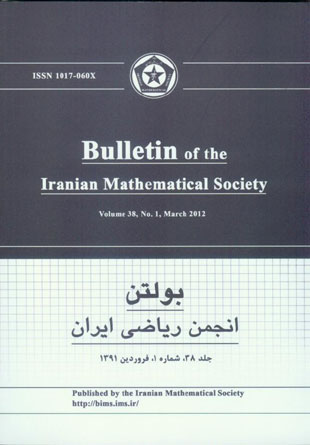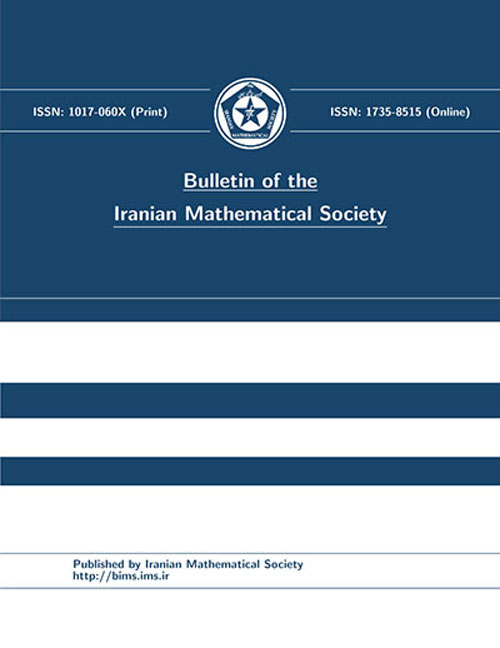فهرست مطالب

Bulletin of Iranian Mathematical Society
Volume:38 Issue: 1, 2012
- تاریخ انتشار: 1391/06/11
- تعداد عناوین: 20
-
-
Page 1We study the topological centers of $nth$ dual of Banach $mathcal{A}$-modules and we extend some propositions from Lau and "{U}lger into $n-th$ dual of Banach $mathcal{A}-modules$ where $ngeq 0$ is even number. Let $mathcal{B}$ be a Banach $mathcal{A}-bimodule$. By using some new conditions, we show that $ Z^ell_{mathcal{A}^{(n)}}(mathcal{B}^{(n)})=mathcal{B}^{(n)}$ and $ Z^ell_{mathcal{B}^{(n)}}(mathcal{A}^{(n)})=mathcal{A}^{(n)}$. We get some conclusions on group algebras.Keywords: Arens regularity, bilinear mapping, topological center
-
Page 17Let $mathfrak{L}$ be the Virasoro-like algebra and $mathfrak{g}$ its derived algebra, respectively. We investigate the structure of the Lie triple derivation algebra of $mathfrak{L}$ and $mathfrak{g}$. We prove that they are both isomorphic to $mathfrak{L}$, which provides two examples of invariance under triple derivation.Keywords: Lie derivation, Lie triple derivation, Virasoro, like algebra
-
Page 27We characterize function spaces of Rees matrix semigroups. Then we study these spaces by using the topological tensor product technique.Keywords: Semigroup compactification, completely 0, simple semigroup, topological tensor product
-
Page 39We present a method for the construction of compactly supported $left (begin{array}{lll} 1 & 0 & -1\1 & 1 & 0 \1 & 0 & 1\ end{array} right)$-wavelets under a mild condition. Wavelets inherit the symmetry of the corresponding scaling function and satisfies the vanishing moment condition originating in the symbols of the scalingfunction. As an application, an example is provided.
-
Page 55Let $alpha$ be an endomorphism and $delta$ an $alpha$-derivationof a ring $R$. In this paper we study the relationship between an$R$-module $M_R$ and the general polynomial module $M[x]$ over theskew polynomial ring $R[x;alpha,delta]$. We introduce the notionsof skew-Armendariz modules and skew quasi-Armendariz modules whichare generalizations of $alpha$-Armendariz modules and extend theclasses of non-reduced skew-Armendariz modules. An equivalentcharacterization of an $alpha$-skew Armendariz module is given.Some properties of this generalization are established, andconnections of properties of a skew-Armendariz module $M_R$ withthose of $M[x]_{R[x;alpha,delta]}$ are investigated. As aconsequence we extend and unify several known results related toArmendariz modules.
-
Page 85We investigate compact composition operators on ceratin Lipschitz spaces of analytic functions on the closed unit disc of the plane.Our approach also leads to some results about composition operators on Zygmund type spaces.Keywords: Compact operators, Bloch type spaces, Zygmund type spaces, analytic Lipschitz spaces, differentiable Lipschitz spaces
-
Page 101In this paper, two pairs of new inequalities are given, which decompose two Hilbert-type inequalities.Keywords: Hilbert's inequality, Hilbert, type inequality, integral inequality
-
Page 113We define and study co-Noetherian dimension of rings for which the injective envelopeof simple modules have finite Krull-dimension. This is a Morita invariant dimension that measures how far the ring is from being co-Noetherian. The co-Noetherian dimension of certain rings, including commutative rings, are determined. It is shown that the class ${mathcal W}_n$ of rings with co-Noetherian dimension $leq n$ is closed under homomorphic images and finite normalizing extensions, and that for each $n$ there exist rings with co-Noetherian dimension $n$. The possible relations between Krull and co-Noetherian dimensions are investigated, and examples are provided to show that these dimensions are independent of each other.Keywords: Co, Noetherian, finitely cogenerated, Krull dimension, normalizing extension
-
Page 123We consider the transitive linear maps on the operator algebra $B(X)$ for a separable Banach space $X$. We show if a bounded linear map is norm transitive on $B(X)$, then it must be hypercyclic with strong operator topology. Also we provide a SOT-transitive linear map without being hypercyclic in the strong operator topology.Keywords: Hypercyclic operator, transitive map, strong operator topology
-
Page 131We derive the formulas of the maximal and minimal ranks of four real matrices $X_{1},X_{2},X_{3}$ and $X_{4}$ in common solution $X=X_{1}+X_{2}i+X_{3}j+X_{4}k$ to quaternion matrix equations $A_{1}X=C_{1},XB_{2}=C_{2},A_{3}XB_{3}=C_{3}$. Asapplications, we establish necessary and sufficient conditions for the existence of the common real and complex solutions to the matrix equations. We give the expressions of such solutions to this system when the solvability conditions are met. Moreover, we present necessary and sufficient conditions for the existence of real andcomplex solutions to the system of quaternion matrix equations $A_{1}X=C_{1},XB_{2}=C_{2},A_{3}XB_{3}=C_{3},A_{4}% XB_{4}=C_{4}$. The findings of this paper extend some known results in the literature.Keywords: Quaternion matrix equation, maximal, minimal rank, generalized inverse, real solution, complex solution
-
Page 159A Heyting algebra is a distributive lattice with implication and a dual $BCK$-algebra is an algebraic system having as models logical systems equipped with implication. The aim of this paper is to investigate the relation of Heyting algebras between dual $BCK$-algebras. We define notions of $i$-invariant and $m$-invariant on dual $BCK$-semilattices and prove that a Heyting semilattice is equivalent to an $i$-invariant and $m$-invariant dual $BCK$-semilattices, and show that a commutative Heyting algebra is equivalent to a bounded implicative dual $BCK$-algebra.Keywords: Heyting semilattice, Heyting algebra, dual $BCK$, algebra
-
Page 169The class of $n$-ary polygroups is a certain subclass of $n$-ary hypergroups, a generalization of D{"o}rnte $n$-ary groups and a generalization of polygroups. The$beta^*$-relation and the $gamma^*$-relation are the smallest equivalence relations on an $n$-ary polygroup $P$ such that $P/beta^*$ and $P/gamma^*$ are an $n$-ary group and a commutative $n$-ary group, respectively. We use the $beta^*$-relation and the $gamma^*$-relation on a given $n$-ary polygroup and obtain some new results and some fundamental theorems in this respect. In particular, we prove that the relation $gamma$ is transitive on an $n$-ary polygroup.Keywords: Hypergroup, polygroup, $n$, ary hypergroup, $n$, ary polygroup, derived $n$, ary subgroup, fundamental relation
-
Page 185We consider bivariate mean-value interpolation problem, where the integrals over circles are interpolation data. In this case the problem is described over circles of the same radius and with centers are on a straight line and it is shown that in this case the interpolation is not correct.Keywords: Bivariate, correct, mean, value interpolation
-
Page 193A proper vertex coloring of a simple graph is $k$-forested if the graph induced by the vertices of any two color classes is a forest with maximum degree less than $k$. A graph is $k$-forested $q$-choosable if for a given list of $q$ colors associated with each vertex $v$, there exists a $k$-forested coloring of $G$ such that each vertex receives a color from its own list. In this paper, we prove that the $k$-forested choosability of a graph with maximum degree $Deltageq kgeq 4$ is at most $leftlceilfrac{Delta}{k-1}rightrceil+1$, $leftlceilfrac{Delta}{k-1}rightrceil+2$ or $leftlceilfrac{Delta}{k-1}rightrceil+3$ if its maximum average degree is less than $frac{12}{5}$, $frac{8}{3}$ or $3$, respectively.Keywords: k, forested coloring, linear coloring, maximum average degree
-
Page 203The theory of c-frames and c-Bessel mappings are the generalizations of the theory of frames and Bessel sequences. In this paper, we obtain several equivalent conditions for dual of c-Bessel mappings. We show that for a c-Bessel mapping $f$, a retrievalformula with respect to a c-Bessel mapping $g$ is satisfied if and only if $g$ is sum of the canonical dual of $f$ with a c-Bessel mapping which weakly belongs to the null space of the pre-frame operator of $f$. Also, we prove that composition of pre-frame operator with analysis operator of two square norm integrable c-Bessel mappings are trace class operators.Keywords: Lebesque integral, Hilbert space, C*, algebra, trace class operator, frame theory
-
Page 223This paper is devoted to the spectral theory (more precisely, to the variational theory of the spectrum) of guided waves in an elastic half cylinder. We use variational methods to investigate several aspects of propagating waves, including localization (see Figure 1), existence criteria and the formulas to find them. We approach the problem using two complementaryMethodsThe variational methods for non-overdamped operator pencils todescribe eigenvalues in definite spectral zones, and Ljusternik-Schnirelman critical point theory to investigate eigenvalues in the mixed spectral zone where the classical variational theory of operator pencils is not applicable.Keywords: Propagating waves, eigenvalue, variational principle, critical point
-
Page 241n this paper, at first the concept of Caputo fractional derivative is generalized on time scales. Then the fractional order differential equations are introduced on time scales. Finally, sufficient and necessary conditions are presented for the existence and uniqueness of solution of initial value problem including fractional order differential equations.Keywords: Time scales, differential equations, initial value problem, fractional order derivative
-
Page 253We investigate the stability of generalized derivations on Banach algebras with a bounded central approximate identity. We show that every approximate generalized derivation inthe sense of Rassias, is an exact generalized derivation. Also the stability problem of generalized derivations on the faithful Banach algebras is investigated.Keywords: Hyers, Ulam, Rassias stability, generalized derivation, bounded central approximate identity, faithful Banach algebra
-
Page 265Let $fM(X)$ be the space of all finite regular Borel measures on $X$. A general measure algebra is a subspace of $fM(X)$, which is an $L$-space and has a multiplication preserving the probability measures. Let $cLsubseteqfM(X)$ be a general measure algebra on a locally compact space $X$. In this paper, we investigate the relation between Arens regularity of $cL$ and the topology of $X$. We find conditions under which the Arens regularity of $fL$ implies the compactness of $X$. We show that these conditions are necessary. We also present some examples in showing that the new conditions are different from Theorem 3.1 of cite{7}.
-
Page 275We introduce the notion of strongly $alpha$-reversible rings which is a strong version of$alpha$-reversible rings, and investigate its properties. We first give an example to show that strongly reversible rings need not be strongly $alpha$-reversible. We next argue about the strong $alpha$-reversibility of some kinds of extensions. A number of properties of this version are established. It is shown that a ring $R$ is strongly right $alpha$-reversible if and only if its polynomial ring $R[x]$ is strongly right $alpha$-reversible if and only if its Laurent polynomial ring $R[x, x^{-1}]$ is strongly right$alpha$-reversible. Moreover, we introduce the concept of Nil-$alpha$-reversible rings to investigate the nilpotent elements in $alpha$-reversible rings. Examples are given to show that right Nil-$alpha$-reversible rings need not be right $alpha$-reversible.Keywords: reversible rings, strongly $alpha$, reversible rings, Nil, $alpha$, reversible rings, weakly reversible rings


